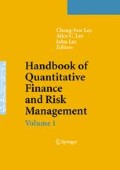Abstract
In 1952, Harry M. Markowitz published a seminal paper about analyzing portfolios. In 1990, he was awarded the Nobel Prize for his portfolio theory. Markowitz portfolio analysis delineates a set of highly desirable investment portfolios. These optimal portfolios have the maximum return at each plausible level of risk, computed iteratively over a range of different risk levels. Conversely, Markowitz portfolio analysis can find the same set of optimal investments by delineating portfolios that have the minimum risk over a range of different rates of return. The set of all Markowitz optimal portfolios is called the efficient frontier. Portfolio analysis analyzes rate of return statistics, risk statistics (standard deviations), and correlations from a list of candidate investments (stocks, bonds, and so on) to determine which investments, and in what proportions (weights), enter into every efficient portfolio. Further analysis of Markowitz’s portfolio theory reveals interesting asset pricing implications.
Access this chapter
Tax calculation will be finalised at checkout
Purchases are for personal use only
Notes
- 1.
- 2.
Problems can arise from using the variance to measure risk. See Szego (2002).
- 3.
The mean and variance may not always provide the optimal selection. See Malevergne and Sornette (2005).
- 4.
Markowitz (1952).
- 5.
The risk formula for a two-asset portfolio is derived below: (EDITOR: Please get this footnote all together on one page.)\(\begin{array}{rl} {r}_{\mathrm{p}} & = {x}_{1}{r}_{1} + {x}_{2}{r}_{2}\quad \mathrm{by\ definition} \\ E({r}_{\mathrm{p}}) & = {x}_{1}E({r}_{1}) + {x}_{2}E({r}_{2})\\ \end{array}\)These two equations are used in the following derivation.\(\begin{array}{rl} \mathrm{Var}({r}_{\mathrm{p}}) & = E{\left [{r}_{\mathrm{p}} - E({r}_{\mathrm{p}})\right ]}^{2}\quad \mathrm{the\ definition\ of\ Var}({r}_{p}) \\ & = E{\left \{{x}_{1}{r}_{1} + {x}_{2}{r}_{2} -\left [{x}_{1}E({r}_{1}) + {x}_{2}E({r}_{2})\right ]\right \}}^{2} \\ & \quad \mathrm{by\ substitution\ for}\ {r}_{\mathrm{p}} \\ & = E{\left \{{x}_{1}\left [{r}_{1} - E({r}_{1})\right ] + {x}_{2}\left [{r}_{2} - E({r}_{2})\right ]\right \}}^{2} \\ & \quad \mathrm{collecting\ like\ terms} \\ & = E\left \{{x}_{1}^{2}{\left [{r}_{1} - E({r}_{1})\right ]}^{2} + {x}_{2}^{2}{\left [{r}_{2} - E({r}_{2})\right ]}^{2}\right. \\ &\quad \left.+2{x}_{1}{x}_{2}\left [{r}_{1} - E({r}_{1})\right ]\left [{r}_{2} - E({r}_{2})\right ]\right \} \\ & = {x}_{1}^{2}E{\left [{r}_{1} - E({r}_{1})\right ]}^{2} + {x}_{2}^{2}E{\left [{r}_{2} - E({r}_{2})\right ]}^{2} \\ & \quad + 2{x}_{1}{x}_{2}E\left \{\left [{r}_{1} - E({r}_{1})\right ]\left [{r}_{2} - E({r}_{2})\right ]\right \} \\ & = {x}_{1}^{2}\mathrm{Var}({r}_{1}) + {x}_{2}^{2}\mathrm{Var}({r}_{2}) + 2{x}_{1}{x}_{2}\mathrm{Cov}({r}_{1},{r}_{2}) \\ & \quad \mathrm{restating\ definitions}\\ \end{array}\)
- 6.
For more information about mathematical portfolio analysis, see Francis and Alexander (1986).
- 7.
Portfolio solutions depend on the covariance matrix. See Stevens, G. V. G. “On the inverse of the covariance matrix in portfolio analysis.” Journal of Finance, October 1998, 53(5), 1821–1827.
- 8.
Additional details and further implications have been published by Francis and Ibbotson (2002).
- 9.
Computer programs to perform portfolio analysis and other forms of investment analysis are available. For an Excel template that you can construct yourself, see Chapter 9 of Craig W. Holden, Excel Modeling In Investments, Second Edition, Prentice-Hall, Upper Saddle Ridge, New Jersey, 2005, ISBN: 0-13-142426-2. Or, see Chapters 5 and 6 of Holden’s Third Edition book entitled Excel Modeling and Estimation, 2009.
References
Francis, J. C. and G. Alexander. 1986. Portfolio analysis, 3rd ed. Prentice-Hall, Englewood cliffs, NJ.
Francis, J. C. and R. Ibbotson. 2002. Investments: a global perspective, Prentice-Hall, Upper Saddle River, New Jersey, ISBN: 0-13-890740-4.
Holden, C. W. 2005. Excel modeling in investments, 2nd ed. Prentice-Hall, Upper Saddle Ridge, New Jersey, ISBN: 0-13-142426-2.
Holden C. W. 2009. Holden, excel modeling and estimation, 3rd ed. Prentice-Hall, Upper Saddle Ridge, New Jersey.
Markowitz, H. 1952. “Portfolio selection.” Journal of Finance 7(1), 77–91.
Markowitz, H. 1959. Portfolio selection. Cowles Foundation monograph, 16 Wiley, New York.
Malevergne, Y. and D. Sornette. 2005. “Higher-moment portfolio theory; capitalizing on behavioral anomalies of stock markets.” Journal of Portfolio Management 31, 49–55.
Stevens, G. V. G. 1998. “On the inverse of the covariance matrix in portfolio analysis.” Journal of Finance, October, 53(5), 1821–1827.
Szego, G. 2002. “Measures of risk.” Journal of Banking and Finance 26, 1253–1272.
Author information
Authors and Affiliations
Corresponding author
Editor information
Editors and Affiliations
Rights and permissions
Copyright information
© 2010 Springer Science+Business Media, LLC
About this chapter
Cite this chapter
Francis, J.C. (2010). Portfolio Analysis. In: Lee, CF., Lee, A.C., Lee, J. (eds) Handbook of Quantitative Finance and Risk Management. Springer, Boston, MA. https://doi.org/10.1007/978-0-387-77117-5_16
Download citation
DOI: https://doi.org/10.1007/978-0-387-77117-5_16
Publisher Name: Springer, Boston, MA
Print ISBN: 978-0-387-77116-8
Online ISBN: 978-0-387-77117-5
eBook Packages: Business and EconomicsEconomics and Finance (R0)

